MENU
> Watch Gangoji > Explanation of features of each building
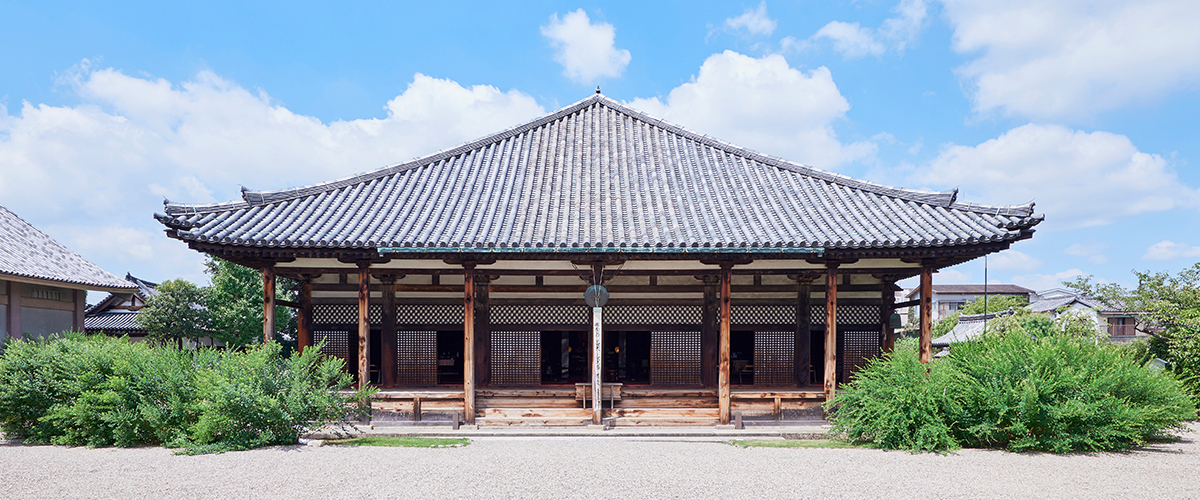
Three parts of the priests’ large living quarters on the east room of the south floor (Higashi-muro Minami-kai Daibou) were made by Yosegi-zukuri constructing technique, and they were remodeled into a temple with a total area of 10.8m x 7.2m. One of the priests’ rooms (Gokuraku-bo) in the nave is a sanctuary. The Azuma is at the front near the altar, and the stately building is done in the Shinwayo style of the Kamakura Era.
It’s a famous traditional temple in Nanto known as the sacred place where the Jodo sect was born.
One Kazuga miniature shrine, one Shumidan altar, and one Akadana shelf
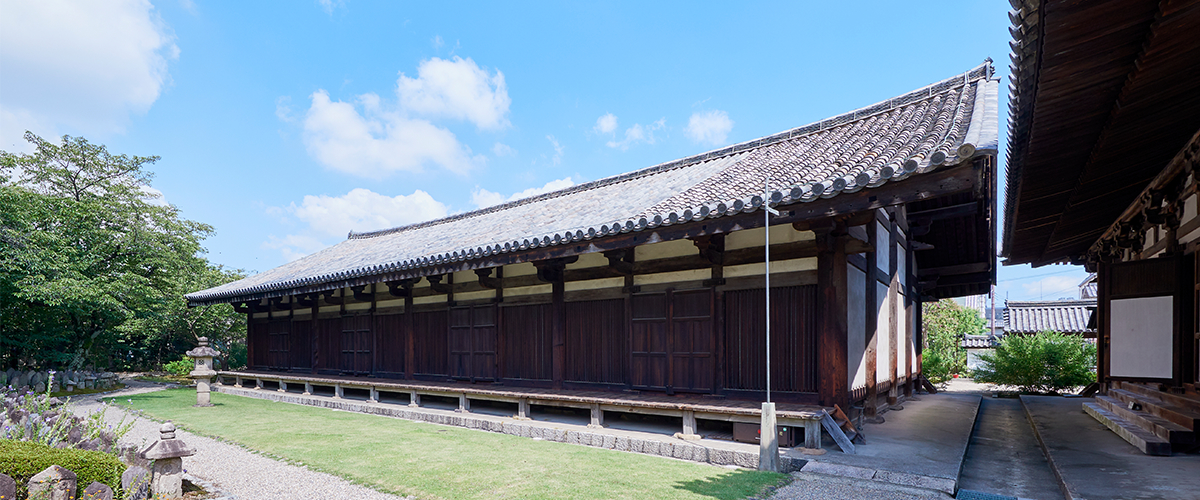
Zen Room is the remains that were conserved from the old Gangoji temple such as the fourth room of the priests’ living quarters in the east room of the south floor (Higashi-muro Minami-kai Daibou). It has a simple, but solid feel with a triangular roof and a traditional tiled roof on all four sides.
This is the remains of the state-sponsored temple priests living quarters where many scholar priests boarded and learned. The layout and atmosphere are well maintained today. The architecture is in the Daibutsu style of the Kamakura Era, and the materials are consisted of old wood re-used from before the Nara Era.
In the Middle Ages, it was also called Kasuga Yogo-do. In modern times, it was used as a guesthouse, and recently it’s been used as a school. The room in the southwestern area was Yogono-ma and could have a Shumidan altar or a feretory. And the northwestern area was the priests’ living area in the Middle Ages.
The southwestern Zen room, a national treasure, was known as the Yogono-ma. It was used to store treasures. According to the “Nanto Gangoji Betsu-in Gokuraku-bo Engi narrative scroll”, long ago when the Yogono-ma Zen room was used to store Buddhist sutra including the Chiko Mandala, Kobo Daishi Kukai would study scripture there every day. One day, when Kukai was praying to the Chiko Mandala, he noticed that the Kasuga Daimyojin deity was standing in the shadows (yogo). Feeling honored, he depicted the scenery in Kasuga Mandala enshrined there. At that time, Kukai carved a portrait of himself (his shadow figure) as statuary and placed it in that room. That’s how the room got its name.
According to the “Gangoji Betsu-in Gokuraku-bo Engi Emaki narrative scroll”, the image that Kukai carved of himself is kept in the Horinkan. Please take a look when you have time.
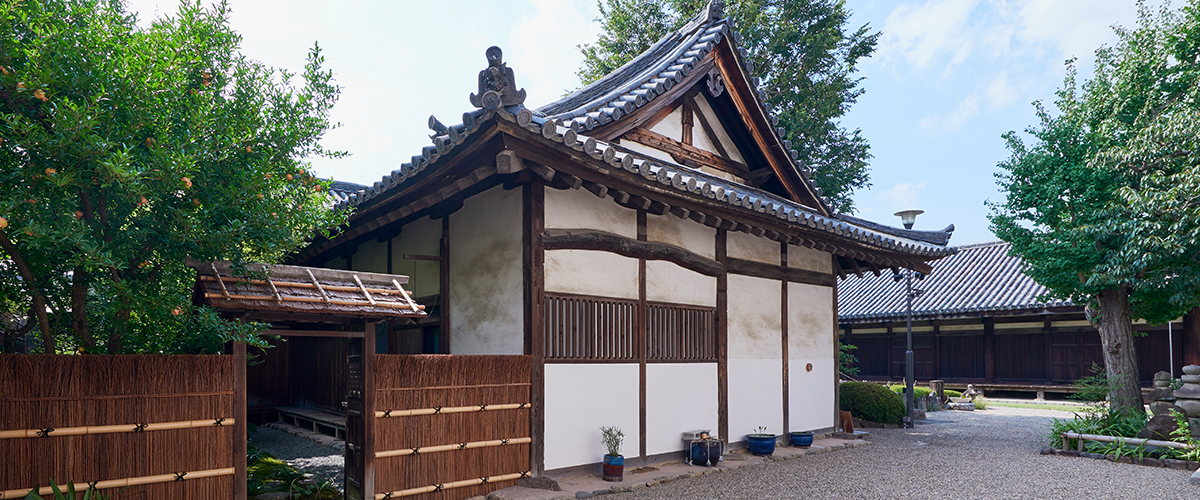
Formerly on the north side of the Zen room, part of the Shoshibo in the east room on south floor was reconstructed. It was called the north kitchen or just the kitchen. In 1663, it was reconstructed as Gokuraku-in Kuri. In 1949, the south side of the Main Hall was moved and enlarged and turned into day-care center for children. And in 1960, it was moved to its present location and restored. From an old dormitory for priests “Samiryo” to a modern temple kitchen, this building holds a unique history and a lot of value.
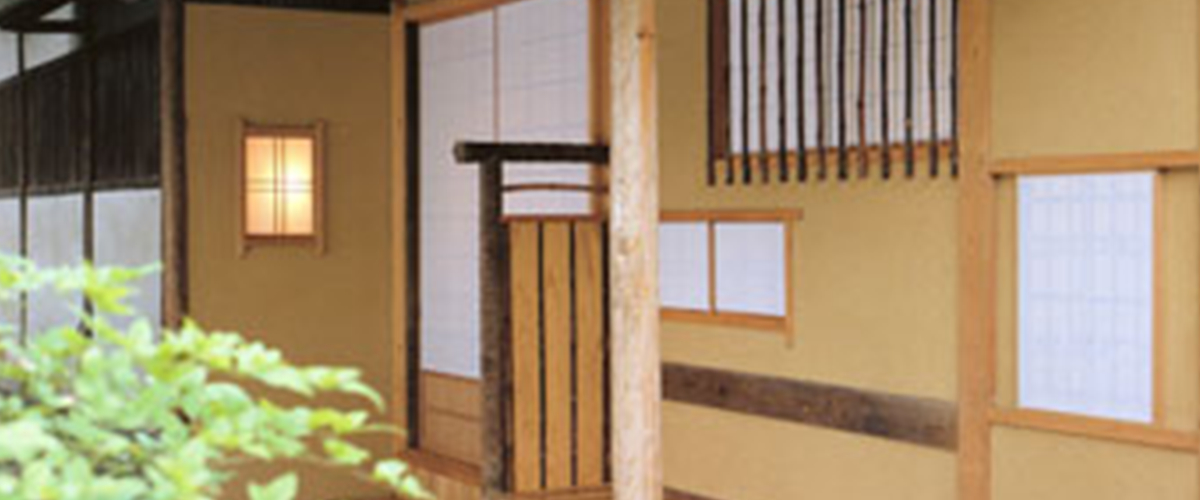
Placed on the west side of Shoshibo, the tea-ceremony room of four and a half Tatami mats and the three mats for the cupboard where tea utensils are kept are made of old wood from Gangoji and are featured with cabinetwork by Kawasaki Yugen. Please make sure you see the lovely space for tea ceremony and the polished craftsmanship of Kawasaki Yugen’s cabinets. You’ll notice his affection for old wood and Kasuga cedar. The “four gentlemen” (a Chinese art term signifying four flowers) have been planted around the backyard garden; the arranged stones include a cornerstone from Gangoji’s belfry, Kurama stones and Shirakawa stones, making a lasting impression on visitors.
Usually not on public display
Reservations are required for field trips and those interested in using the garden (Please contact Gangoji temple)
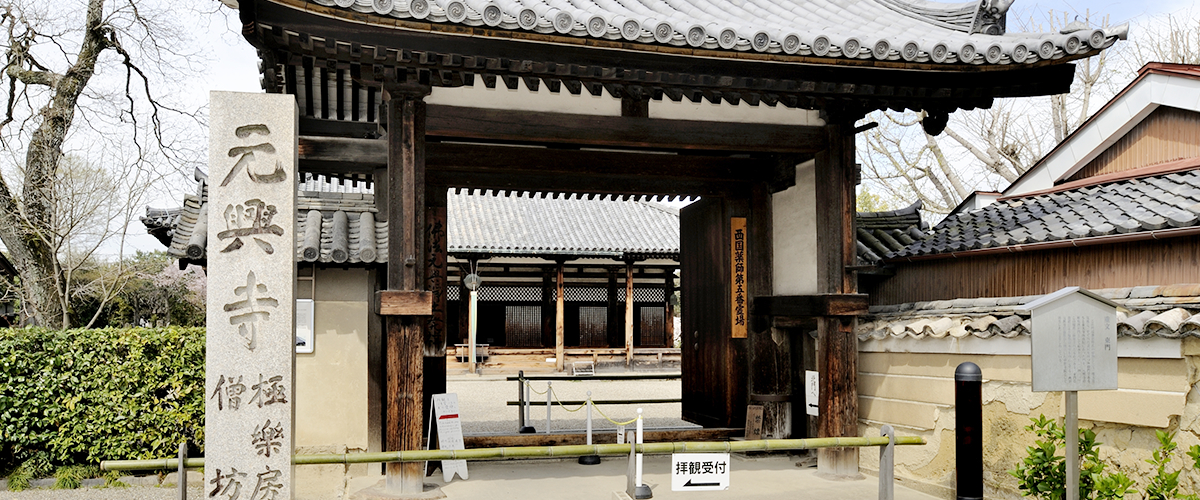
It was recorded that the Todai-ji temple’s Nishi-minami-in Yotsuashi Gate was moved during the Ouei period and is the Gangoji Gokuraku-bo Main Gate. It’s a wonderful Kamakura Era style gate. The priests’ living quarters in the east room of the south floor of Gangoji was reconstructed into Gokuraku-do Hall and the Zen Room. The east-facing Middle Ages temple’s character was changed at this point to the Gangoji Gokurakuritsu-in (Nanto Gokuraku-in). The remains of the Gangoji Daijo-in Monzeki were thought to be partly rehabilitated.
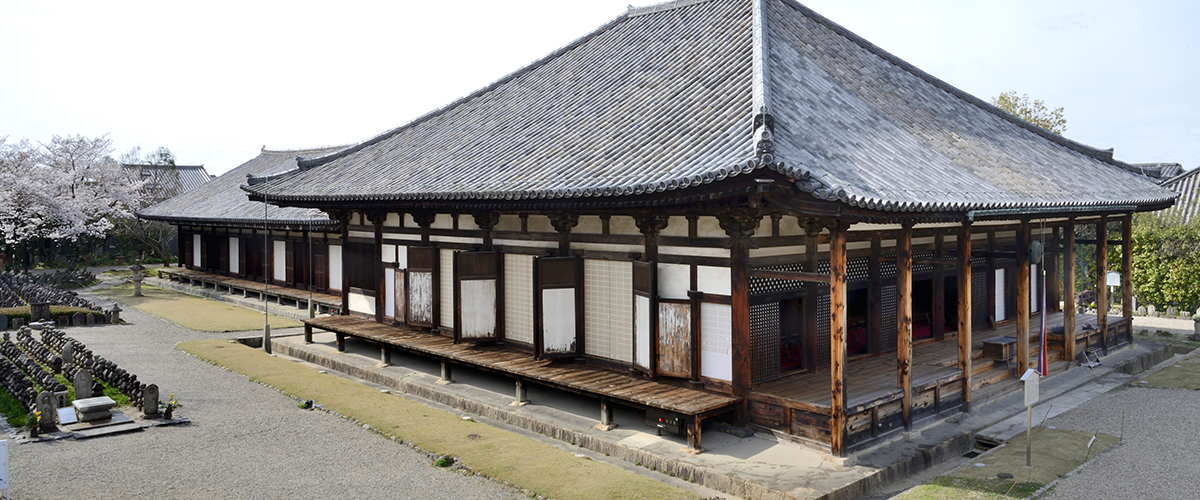
Within the old Gangoji temple area, the priests’ living quarters and auditorium were called Gangoji Gokuraku-bo in the Middle Ages, and Nanto Gokuraku-in in modern times.
Also, the remains of the Gangoji tower (the base of the Todai five-storied pagoda and the Shoto-in small tower (part of Nishi Shoto-in) were recognized by the nation. However, much of the remains are under the streets and private homes. Furthermore, the one cornerstone of the belfry and three cornerstones of the auditorium were transported from the excavation sites to a separate place for preservation.
Futoden (tombstones and stone Buddhist images), which was refurbished in 1988, was deified in connection with the tomb by the Daijo-in Monzeki at Gangoji. From the Middle Ages through the Edo Era, there were 1,500 Buddhist stoneworks here.
Every year on August 23 and 24, a Jiz
o-e memorial service is held with 10,000 votive candles on small plates dedicated to Jizo-son. It’s a festival that symbolizes the end of summer in Naramachi.
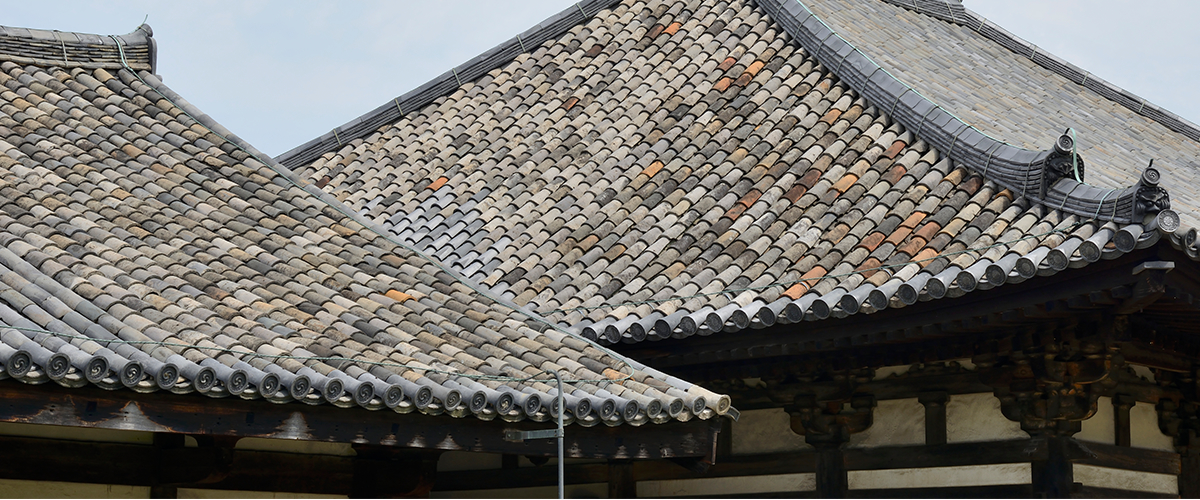
The northern and western flow of the tiles on the roof of Gokuraku Hall, and the southern and eastern flow of the tiles on the Zen Room have a look that is a little different from regular tiles.
The rounded and flat tiles overlap. They use old-style tiles from the Asuka Era (founded as Hoko-ji). The phrase “Horuyu-ji tamashinozushi” refers to these rounded tiles. They are still found on one part of the auditorium roof at To-ji in Kyoto, the lower layer of the pagoda at Fukakusa Hoto-ji temple, Kuginashi-do Hall at Koon-ji temple, Daido Main Hall at Ooita Fuku-ji.
With Gangoji, dismantling and repairs allowed old tiles (dating from the Asuka Era) to be used. Also, something to be noted are the old, eave-end roof tiles or plain tiles that remain in the southwest corner of Gokuraku-bo Hall and the southeast corner of the Zen Room.
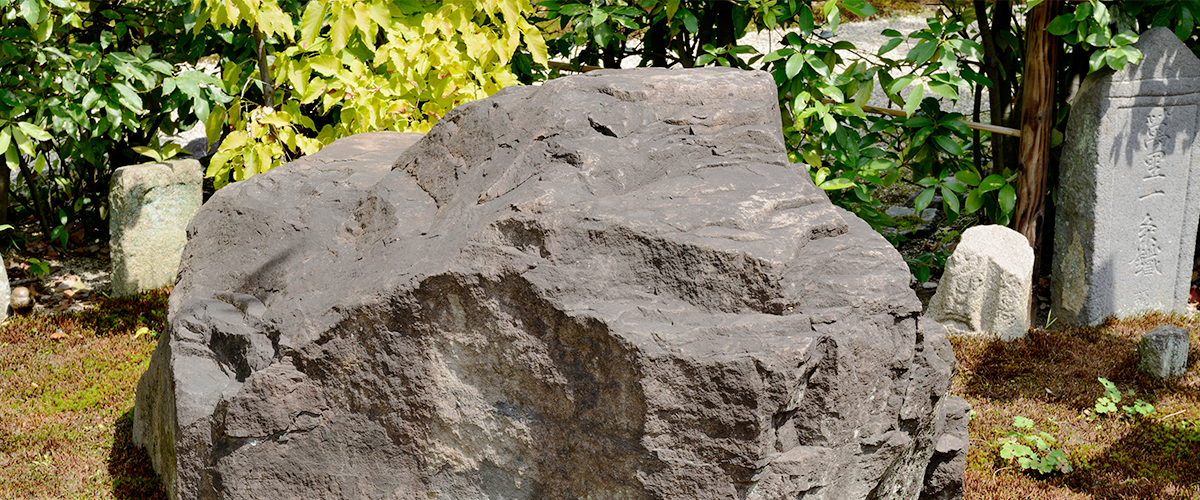
The stone on the northern part of the Gangoji temple grounds that looks like a toad has been famous for a long time and is known as the Frog Stone. The Frog Stone was part of a memorial service for deceased people with or without people to mourn them that gave it its current status as a Gokuraku Frog. The Gokuraku Frog, which stands facing Gokuraku-do Hall, listens to people’s prayers to return home safely or have a turn of luck, playing off the homonyms in Japanese of frog (kaeru) and return, or go home (kaeru).
Every year on July 7, a Frog Stone memorial service is held. The story goes that the Frog Stone originally was found by the riverside. Toyotomi Hideyoshi took an interest in it and had it moved to Osaka Castle. When Osaka Castle fell, it was explained that his wife Yodo-gimi was buried underneath the Frog Stone. After the fall, at some point, the stone was moved to a turret by the moat embankment. Around this time, the Frog Stone took on a mysterious power, and people started jumping into the moat to kill themselves from the place where the Frog Stone placed. Or the bodies of those who committed suicide in this moat would float over to where the frog stone was. All sorts of strange things started occurring.
People came to fear the Frog Stone. After World War II, it went missing. But in 1958, linked by fate,, it found its home at this temple. Today, it sits facing the national treasure Gokuraku-do Hall.
In China, it’s said that birds inhabit the sun, and rabbits and toads inhabit the moon. The toad is thought of as a water spirit, and lives in the moon to make it rain. The frog is a memorable creature, sporting both arrogance and charm. And the Frog Stone is connected to Toyotomi Hideyoshi, Yodo-gimi and the mysteries at the moat of Osaka castle.
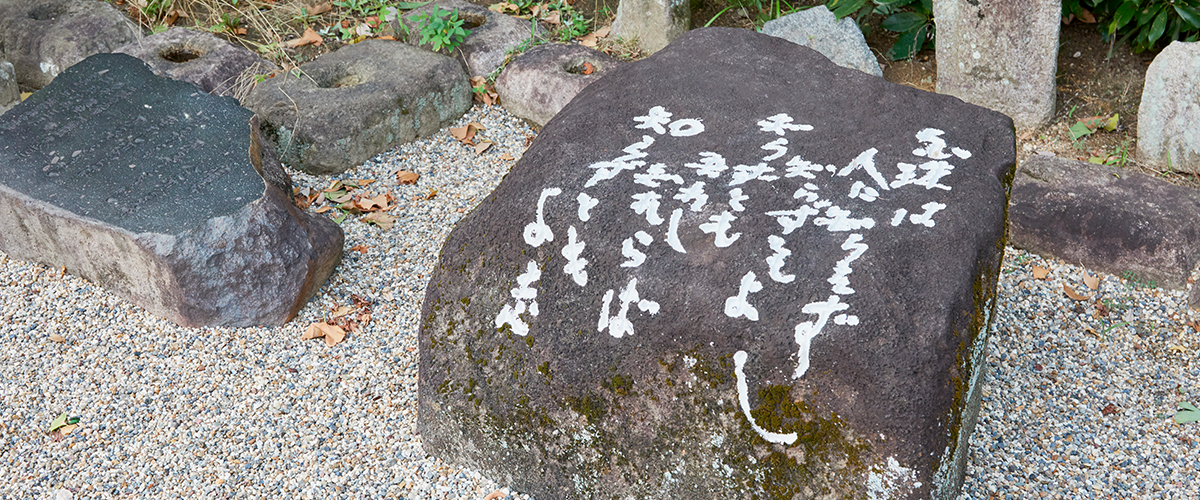
Supervision and explanation from Professor Honda Giken
(Specialist that worked on group supporting the Manyo Poem monument in Nara City, honorary professor at Nara Women’s University)
The Poem from 738. “Gangoji no Sato”, transferred from Asuka to Heijo-kyo, bustled with the talented women in the long skirts worshipping at the temple (volume 6, No. 992). Among the priest group, there were scholars of the Three Treatises studies and scholar priests of the Jodo Mandala lore, including Chiko. but the poem laments the worthiness of one of them, who, even being enlightened, was not recognized for his talents. Reaching enlightenment alone is not an easy path as the scriptures are difficult, but there is no need to elaborate on that now.
The white bead can be interpreted as pearl from pearl-bearing oysters, or beautiful white stone or jewel, and in love poems, it is often a figure of speech denoting a woman. Today, it is used by writers to compare to the world itself. “People don’t know the value of these pearls. It’s OK if they don’t know. As long as I know, it’s OK if they don’t.”
“I don’t care if others don’t know.” Almost like the Analects of Confucius.
The song is written in the Sedoka form 577/577. It often includes a question, an answer and the reasons. Or a synonymous phrase is repeatedly sung. It was trendy during the Heian Era. The same music and same lyrics are repeated in the old form, but the old meaning of a “pearl” and “to know” meaning the pursuit of a woman have been changed to knowing someone intellectually. “Yoshi” has been rendered different ways depending on people’s judgment, accepting that which we don’t want to admit, with a little room for soliloquy to push through.
Poem of the Tenpyo priest intellectual group. At any rate, let’s make the Gagoze demon dance.
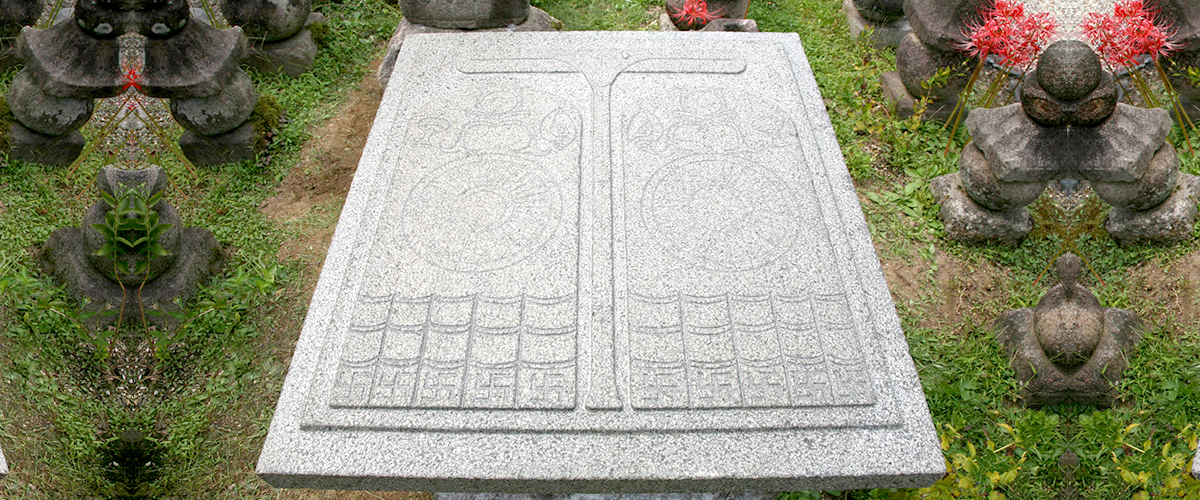
In front of the Futoden located on the south side of the temple grounds among a stone tower and Buddha statues, is a stone Buddha foot monument carved out of Ajiishi granite measuring 75 cm in height and width, and 15 cm in thickness.
The foot stone was worshipped in ancient India’s Buddhist areas as a monument to the living Lord himself in an era that predated Buddha statues.
It was said that the worshippers would clasp the foot monument with both hands and touch their foreheads to the stone to show respect. It is still believed that just touching the stone conferred great karma upon the worshipper. In Japan, belief in Buddhism and its precepts were in a recovery period, just as it is now. The Sri Lanka foot stone symbolized the footprint on the holy crest and was known for its big, open umbrella. A service was held to honor the deep ties of friendship between this temple and Sri Lanka. The building process is cut into the side of the Buddha foot stone. Here is what it says:
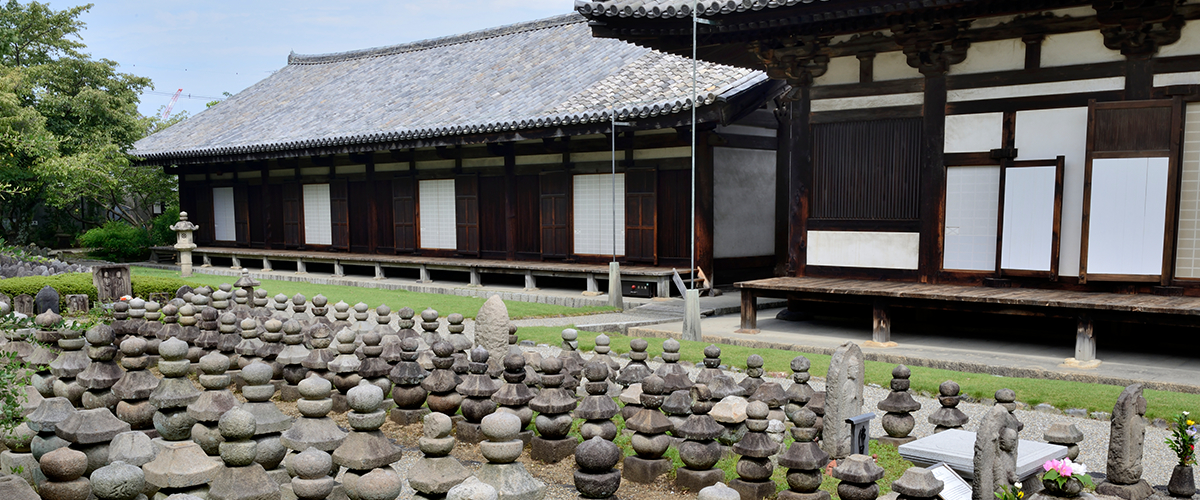
When you visit Gangoji, the first thing likely to draw your attention is the orderly line of tombstones. Until fairly recently, the stones were piled up on the northwest side of the Zen Room, but in 1988, they were lined up as they are today and called Futoden. “Futo” refers to Buddha, and just as the characters suggest, Buddhist images and stupa are lined up like a rice field in this place. The tombstones take on all sorts of forms. Let’s look at the different types.
The one that draws your attention is the five-tier stone grave marker that combines five different parts. The five-tier grave marker was made based on the doctrine of Esoteric Buddhism, with the five elements that compose the universe represented: earth, water, fire, wind and air. The tomb is shaped to represent Dainichi Nyorai (Mahavairocana) and Amida Nyorai (Amitabha Tathagata).
Next, though there are few left, the important treasure towers named “Houkyointo”. These were originated from metal King Ashoka towers built in China in the 10th century. Ornaments are featured prominently in the four corners of the roof. “Houkyointo-louny,” an important scripture that describes acts of charity (divine favor) was put in the one called Houkyointo. Moreover, what is called the Funagata Five-Tier Tower (Hokyointo) is two shapes of towers relieved or engraved on the boat-shaped monument. These five-tier towers and Houkyointo towers were plentiful in the Kamakura and Sengoku eras. The stone monuments were seen a lot in the Sengoku Era up through the Edo Era. There are also stone Jizo statues depicting Amitahba or Jizo within the limits of a stone frame, natural stones with engravings on them and all sorts of other stone items beyond Futoden scattered throughout the temple grounds.
Priests’ names, like Doi or Miyoku, are carved into the towers. Gangoji in the Middle Ages was one of the family temple tombs of Kofuku-ji Daijo-in, which is why there are a lot of stone towers to priests, but there also other types of people who got Buddhist names at the end. There are also “Gyakushu” monuments in which people who were still living built a tower for their safe passage to heaven. It must have cost a lot to build a stone tower back then, which means people building these Gyakushu monuments were likely wealthy elites.
Gangoji is home to a wide array of stone monuments. But there were hardly any regular tombstones like we have seen since the Edo Era. Before the Edo Era, Gangoji was designated as the temple to pray for the Tokugawa family, so there wasn’t a need for regular tombs for the townspeople. In this way, the stone towers tell the story of Gangoji’s long history.
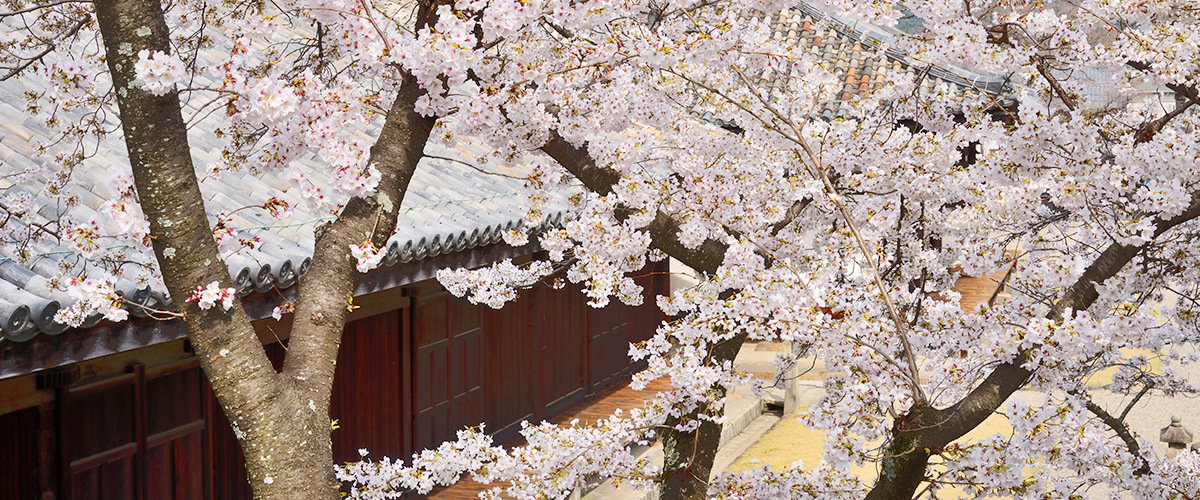
There are some famous cherry-blossom viewing sites around the old grounds of Gangoji. One is Gangoji’s Yogo Sakura. Cherry blossoms flutter down on the national treasure Zen Room, and that is reminiscent of a very ancient spring.
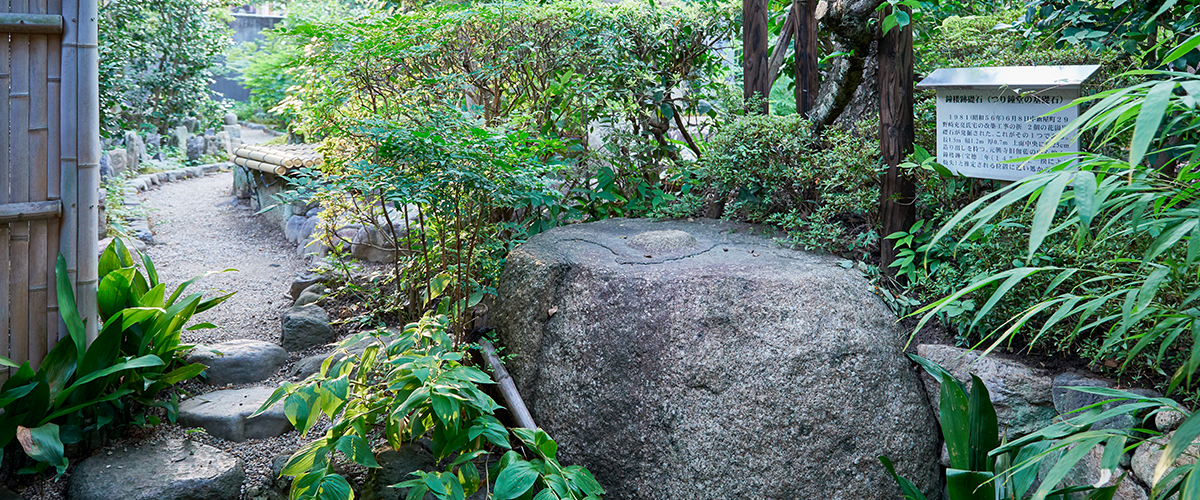
There are the belfry cornerstone on the north side of Shoshibo. It was discovered in 1981 at Nakano-shinyacho. The central pillar has prominence.
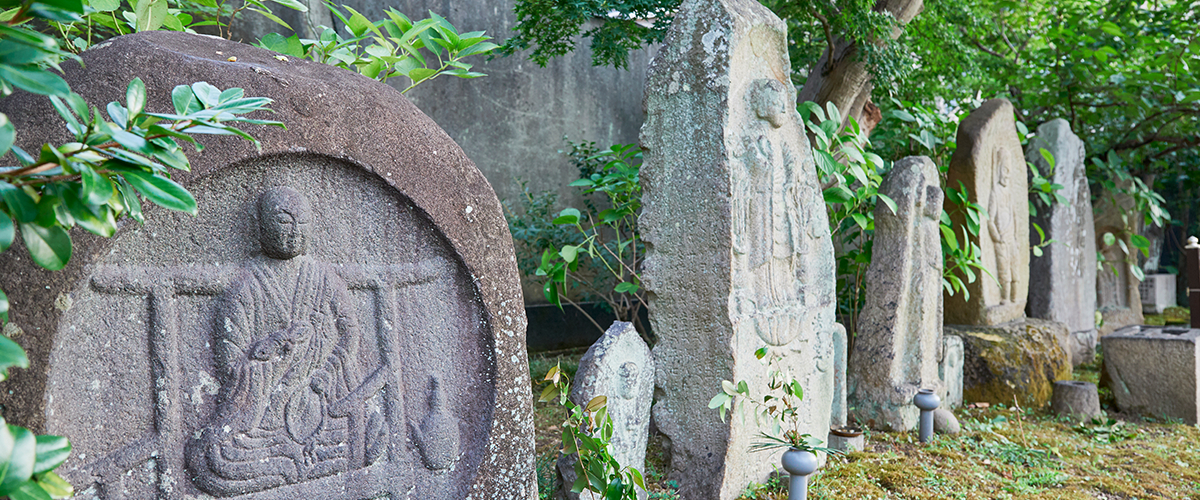
You’ll notice the monuments and stone Buddhist images on the south of the East Gate parking lot. Most of Gangoji’s stonework is in Futoden. Some people feel strange to find these independently lined up. These were not original
In 1936, about 1km to the south of Gangoji in the factory site in Nara Kainozuka, a new Fudo hall was built to enshrine Fudo Myo-o. The stonework dispersed in nearby places such as Iwai River and the Minami-kyobatecho Fuku-dera pond were moved here. Then, almost 70 years later in 2002, when the company operating the factory changed, the Fudo hall was removed. With nowhere to go, the stonework found a stable home at Gangoji. Today, every July 28, the people of Kainozuka gather to hold a memorial service.
Most of the stonework here dates from the Muromachi through the Edo eras, and it is mainly Buddhist images used in memorial services for the dead, but there are some pieces of deep interest. The stonework written with six characters, “Namu Amidha Buddha,” was made for a gathering of 52 people at a memorial service in 1579. It has been shown to be put together by a religious organization in a town in Nara during the Sengoku Era. Also, in 1868, a Mt. Omine monument was built in honor of Okudaya Heizo, who climbed the mountain 50 times. There are valuable materials here that shed light on former faiths. Gangoji is not just a place for one kind of worshippers; there is material gathered here on a multitude of faiths.
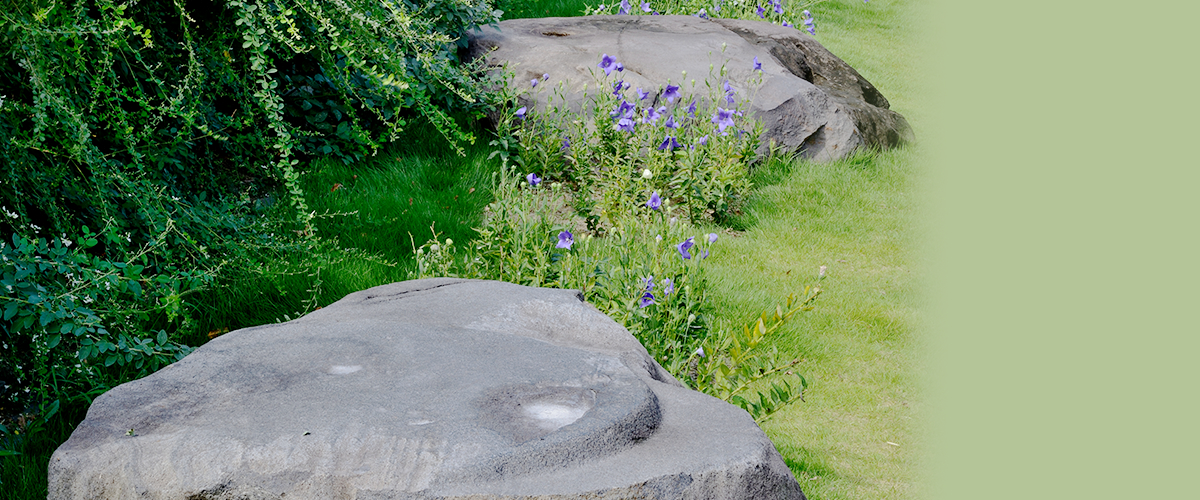
There are three sets of cornerstones on the north side of the Horin-kan Hall. They were discovered in 1998 during an excavation conducted in Nakashinya-cho by the Nara City Board of Education. The cornerstone was buried in a hole in the early part of the Edo Era. Considering the spot it was found, it seems to have been part of the auditorium. The surface of the pillar base was 80-90cm in diameter. It can be assumed, that it held a pillar about the same size of 80-90cm. We can begin to know how wonderful this auditorium was thanks to these clues.
Set in the land of beginnings with a history spanning 1,300 years,
Gangoji is a National Treasure and World Heritage Site of Nara.